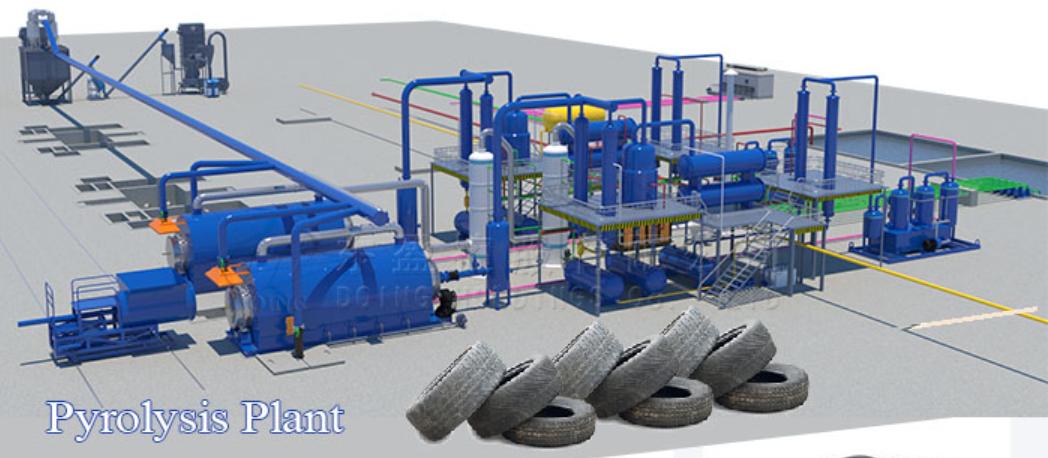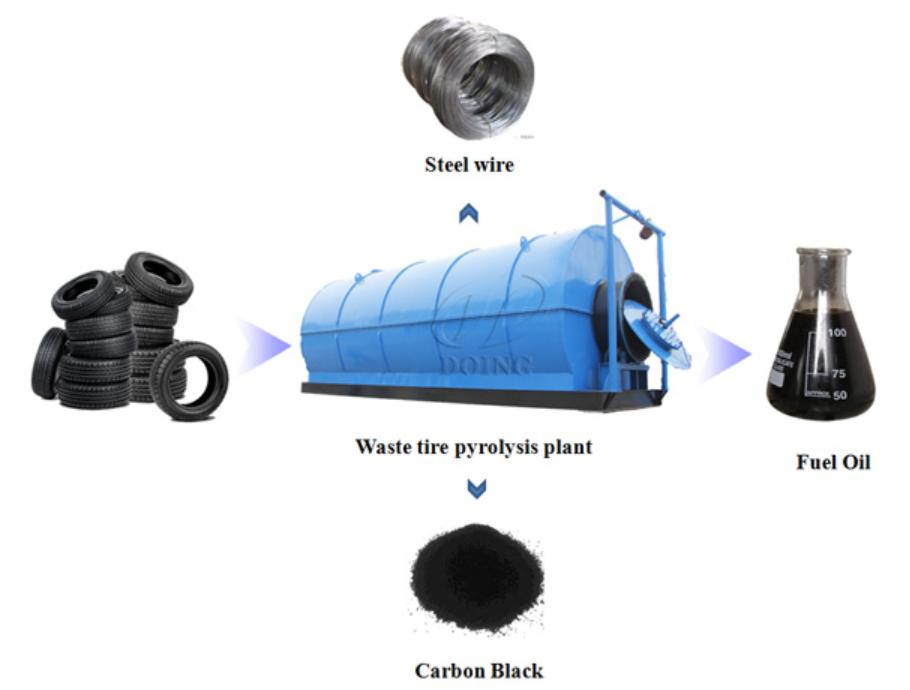
Combining waste tyre pyrolysis with matching waste treatment methods offers mutual advantages. This integration boosts resource reclamation and environmental sustainability. Co-treating tyres with biomass, plastics, or everyday refuse allows operators to maximize energy effectiveness and lessen environmental harm. This detailed investigation examines the technical, financial, and regulatory aspects of these combinations. The discussion is supported by Qingdao Xingfu Energy‘s novel approaches.
Waste tyre pyrolysis is increasingly seen as a sustainable way to handle one of the planet’s most stubborn waste flows. It thermally breaks down tyres without oxygen. This transformation turns them into useful secondary materials. It cuts down environmental dangers and enables material reuse.
Pyrolysis heats shredded or complete tyres. This happens without oxygen. Temperatures range between 400°C and 700°C. This heat-driven breakdown decomposes complex rubber polymers into simpler molecules. The operation produces a blend of solid outputs, liquid outputs, and gaseous outputs. Solids include carbon black and steel. Liquids include pyrolysis oil. Gases include syngas. Direct waste tyre pyrolysis creates gas, pyrolysis oil, and char.
The reaction steps involve depolymerization and fragmentation. Secondary reactions also occur, like cyclization or aromatization. These reactions absorb a lot of heat. Precise heat management is vital. This maximizes oil production. It also minimizes unwanted secondary materials.
The main results are:
Fuel oil (40–45%)
Carbon black (32–36%)
Steel wire (14–16%)
Syngas (5–8%)
These materials can be refined. They can also be reused directly in industrial settings. Examples are heating furnaces, metal processing, or as chemical starting materials. The huge yearly creation of discarded tyres presents difficulties. Disposal is a major challenge. Creating practical and expandable treatment options is both urgent and critical. It is vital for sustainable waste handling and energy reclamation.
Qingdao Xingfu Energy provides different models. These include whole tyre and shredded tyre pyrolysis plants. They use multi-stage cooling circulation setups. This maximizes fuel oil yield. It also guarantees operational effectiveness with very little worker input.
Combining processes unlocks extra benefits. It improves material reuse, enhances energy effectiveness, and reduces environmental harm. This is achieved by merging complementary waste flows.
tyres can be added to MSW incinerators or gasifiers. This balances energy values. Their high energy content supplements low-energy MSW parts. However, blending needs careful feedstock standardization. Discarded tyres have a complex makeup. They have a high heating value (30–40 MJ/kg). They also have low water content. This sets them apart from other organic wastes. It makes them suitable for combined setups. Here, they can act as extra fuel sources.
Biomass pyrolysis setups can be adjusted to handle rubber-based items like tyres. Co-pyrolyzing biomass with tyres might enhance syngas quality. This is due to beneficial interactions in thermal decomposition paths. This combination also allows better use of shared heat exchangers or condensers. It improves heat effectiveness across both operations.
Plastic and tyre pyrolysis share similar running conditions. Qingdao Xingfu Energy offers both fully automatic plastic pyrolysis plants and semi-automatic units. This makes it possible to create modular hybrid facilities. These can manage mixed plastic-rubber waste flows.
Qingdao Xingfu Energy backs these integrations. It does this through modular plant plans. These can handle multiple input materials. They maintain high product recovery rates. Fuel oil recovery can reach up to 85% in plastics pyrolysis systems.
Linking processes improves sustainability. It also boosts financial viability. This happens by reducing repeated infrastructure and activities.
Combined systems enable step-by-step energy use. Waste heat from one unit powers another. This multi-purpose method greatly improves total waste heat reclamation efficiency. It does this across all linked units. For instance, syngas made during tyre pyrolysis can fuel biomass dryers. It can also power plastic melters within the same site.
Carbon capture methods like MEA absorption can be centralized. This happens across integrated units. It reduces CO₂ emissions collectively. This is better than doing it separately for each process line. Carbon capture technology successfully reduces CO2 emissions. It supports carbon reduction goals.
Shared utilities lower capital spending per ton handled. Examples are boilers, condensers, scrubbers, or cooling towers. This makes integration financially appealing. It is especially so for small-to-medium businesses targeting varied waste flows.
Qingdao Xingfu Energy meets these needs. It offers fully automatic systems. These cut worker expenses. They also increase throughput efficiency. Only 2–3 workers are needed daily. This is due to automation features. Examples are submerged arc welding and X-ray detection for safety.
Despite the benefits, integration adds new layers of difficulty. These must be managed carefully during system design and running.
Different input materials have changing physical forms. Whole tyres differ from shredded plastic. They also have different chemical makeups. This demands separate preparation steps. Examples are shredding, drying, or metal removal. This is needed before co-feeding becomes possible.
Co-treating needs advanced control systems. They must adjust reactor conditions dynamically. This is based on real-time input makeup shifts. It ensures steady output quality despite changing inputs. This is a key need for downstream refining units. Examples are distillation columns or hydrogenation reactors.
Cross-contamination risks exist. Char from one flow might affect the purity of another. For example, sulfur-rich tyre char could lower carbon black quality. This happens if mixed with clean biomass ash. Effective separation after the reaction is essential.
Qingdao Xingfu Energy lessens these issues. It does this through closed-system plans. These ensure airtight feeding at high temperatures. They also maintain clean discharge using pulse dust removal technologies. This achieves environmental compliance without harming productivity.

Regulatory structures play a key role. They speed up adoption by creating favorable financial conditions for combined facilities. This happens through incentives and rules.
Governments globally are pushing circular economy ideas. These prioritize material recovery over landfilling or burning. Integrated pyrolysis fits perfectly with this vision. It converts end-of-life items into reusable resources. This spans multiple areas including energy, building, and chemicals.
Tax breaks, carbon trading plans, or direct subsidies can greatly improve project feasibility. Government bodies should offer grants of at least 38.43 $/ton of waste. This achieves a positive net present value. It is for integrated setups involving pyrolysis plus carbon capture or desalination features.
Integrated plants must meet strict emission rules. This applies across all units. It could be volatile organic compounds from plastics. It could be particulate matter from rubber burning leftovers. This requires strong monitoring systems. They must be built into the plant plan from the start.
Qingdao Xingfu Energy holds certifications. These include AAA credit rating certificates and provincial environmental protection product approvals. It ensures all gear meets local regulatory standards. It also aids clients with paperwork needed for policy benefit access.
As a top maker specializing in pyrolysis equipment design since starting in Qingdao, China,
QINGDAO XINGFU ENERGY EQUIPMENT CO., LTD is a professional manufacturer. It specializes in pyrolysis plants and oil distillation equipment. With wide-ranging experience covering full-scale setups worldwide—including Europe—the company is known for dependable engineering answers. These are tailored to modern waste valorization requirements.
Their offerings include:
Fully automatic tyre & plastic pyrolysis plants
Oil distillation units
Carbon black granulation lines
These modular setups allow simple expansion or blending. It depends on changing client needs across various waste flows. This makes them ideal partners for hybrid facility creators. They target other waste treatment methods at the same time.
Features include multi-stage cooling circulation for higher oil yields and pulse dust removal during discharge. This ensures no dust escapes. Qingdao Xingfu Energy guarantees every setup meets current operational standards. It also stays environmentally compliant. Their after-sales help further ensures long-term dependability. This is a key factor when running complex combined facilities.
Combining waste tyre pyrolysis with other treatment methods presents a transformative chance. It fits within sustainable waste handling plans. It allows beneficial resource use. It also reduces emissions through shared infrastructure. When backed by companies like Qingdao Xingfu Energy, offering complete modular answers, it becomes both technically feasible and financially attractive.
Plastic pyrolysis units, biomass conversion operations, MSW incinerators/gasifiers are very compatible. This is due to similar running temperatures or matching heating properties. It allows effective shared infrastructure use.
Most modern combined systems are made for constant operation. They use automation technologies. This allows smooth feedstock switching between different parts without stopping. This is especially true for systems created by Qingdao Xingfu Energy. They feature fully automatic controls.
Yes. Modular plans offered by makers like Qingdao Xingfu Energy allow adding to current facilities. Space must be available. Alignment on utility needs is also necessary. Examples are electricity load sharing or exhaust gas handling compatibility.